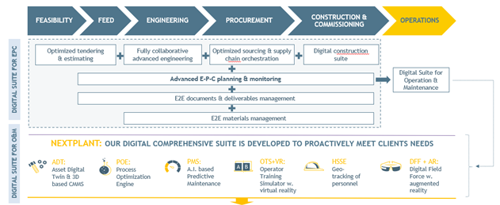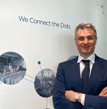Online Exclusive: The evolution of EPC project management
Diana Duca and Guido Tornatore, Maire Tecnimont, Milan, Italy
In a challenging market scenario, the authors’ company identified the priorities to utilizing digital technologies to rethink business models to reduce the costs of new industrial blocks and operation.
The goal of our digital journey was to combine the DNA of an engineering, procurement and construction (EPC) contractor with the state-of-the-art information technology (IT) industry with a business-driven approach. In any project phase, companies must fit the plant owners’ business model, optimizing the most relevant EPC processes by selecting the best technology on the market.
With the goal of “making it simple to make it happen” and leveraging on an adaptive approach, we have experienced that the key for a successful digital transformation is empowering market solutions by connecting them through innovative technological layers and connections. With this approach, one can create a new environment where all project stakeholders can maximize the use of their platforms.
The digital transformation of our core EPC processes led to a digital advantage derived from more accurate scheduling and full transparency. The major change enabled by digital transformation—to shift the focus from deliverable to data workflow—provides companies the ability to carry out project management analysis data directly from sources and avoid hours of waste. It also enhances lessons learned that have been acquired from previous projects.
This digital advantage program enhances the project management teams’ control along EPC phases for excellent and timely execution. This internal digitalization of work procedures is the enabler of NextPlant, the digital suite of Maire Tecnimont Group for enhancing the operation and maintenance of future-ready industrial plants (FIG. 1).

Project Control Tower. The Project Control Tower is one of the main pillars of the authors’ company’s digital advantage to improve EPC processes and enhance performance as an EPC contractor. This platform to supports project governance and offers the project management team and the client a wider and deeper data set. These data sets provide a measurable difference in EPC project execution and in the total investment cost for the client.
Project Control Tower consists of a series of advance reporting apps developed with the Microsoft Power Bi environment, which enables project monitoring and continuous evolution. The engineering activities status is monitored through Power BI document control, which contains the document status and traces them for each discipline. It leans on an electronic deliverable management system (EDMS) to enhance workflows management and notes milestones and business needs. The document management reporting tool reflects the project deliverables status as per the EDMS and deliverable lists platform.
The Power BI reports enable the monitoring of the following primary aspects:
- Total expected documents as per the deliverables list and/vs. actual status
- Status per document class and reason for issue (e.g., issued for design, issued for construction)
- Status per engineering discipline
- Status per vendor/material requisition/purchase order
- Document issue curves and an estimation of engineering work
- List of overdue documents, list of opens comments, among others.
Materials management is monitored through the material control tower, a digital solution for end-to-end advanced supply monitoring for data-driven decision-making. Having advanced real-time reporting on the status of project materials from the material requisition issue to purchase order issue and shipping compared to the project schedule enables the project to better control possible delays through data-driven analysis and scenario-based alternative simulations.
The material control tower enables the project team to visualize the following:
- The status of materials across the supply chain, from materials requisition emissions to arrival onsite, to detect where delays might occur and act rapidly to prevent them
- The status of materials documents across every step to detect possible delays that might occur and act rapidly to prevent them
- The status of non-conformity and any other quality issue that may impact manufacturing and the delivery of the goods
- Potential delays/issues on the supply chain.
Construction activities are monitored through a feasibility app and AWP visualizer. The feasibility digital tools enable an efficient and effective end-to-end process. The 3D feasibility app displays disciplinary and multidisciplinary feasibility analysis results. It highlights actual and forecast work and checks drawings and relevant materials availability to prevent potential delays and enables timely corrective actions.
The 3D feasibility app provides the project and site management teams a vision of where to focus to achieve successful project completion. Alarms can be easily raised to subcontractors for areas lacking progress and proactive actions can be requested to all project stakeholders.
The adoption of an advanced work packaging methodology has a significant impact on worksite efficiency; this is becoming the industry standard to execute construction projects safely and productively. Through an AWP Visualizer and comprehensive data-rich 3D models, all elements of a project can be easily visualized, including the availability of materials and resources. This helps with prioritization and sequence installation based on discretized work-packages, which increases planning and scheduling capacity, mitigating risks and enforcing forecasting capacity.
The digitalization of construction work processes enables a reduction of the overall construction site supervision and the incrementation of the safety of construction phase, as well as the control of quality on executed work.
The quality and health, safety and environment (HSE) aspects are monitored through the quality control app, punch list app and the HSSE platform. The inspection app for construction quality control is an advanced digital tool that supports an efficient management of construction request for information (RFI) and field inspection activities. These operations are conducted directly on mobile applications to speed the process through automatic updates and digital site dossier copies.
Implementing the quality control app creates a value that has a direct connection with moving towards a greener project—it eliminates waste be removing excess records and registers in hard paper copies. The use of the quality control app can lead to an increase in efficiency of 40%, a reduction in the time to acquire certifications by 30%, provide a quicker project handover to the client, automatically update the RFI logbook, directly update reporting systems and provide a digital copy for users.
The punch list app provides punch lists identification, classification, closing and handover through a tracked end-to-end process that can be remotely accessed. The punch list app revolutionizes the way punching is done in the field, reducing manual effort and the duplication of information while increasing efficacy of actions and overall site efficiency toward mechanical completion.
The environment, health and safety management (EHSM) platform is an advanced digital tool that supports an efficient management of HSE activities. The application records and monitors all HSE events, with an effective and corrective actions control system and follow up.
Recording HSE performance indicators leads to an optimized site HSE surveillance and provides an extensive view for all construction site and data aggregation at various levels.
Takeaways. The adoption of the Project Control Tower during the project lifecycle has a significant impact on all construction phases of a project, enabling early detection of potential delays or issues, upfront decision-making processes, major transparency, predictability, extended team organization and collaboration. It supports an excellent EPC execution by mitigating the risk of delays and reworks during the entire project lifecycle.
Authors

Diana Duca joined Maire Tecnimont's Digital Portfolio Management Team in 2020 as a Change Agent in the company's digital transformation journey. She has more than 10 yr of quality assurance and operational excellence experience in leading companies worldwide in the oil and gas, petrochemicals, renewables and fertilizer sectors. During her career, she has had significant experience in auditing activities, the development of procedures and standards in support of globally defined processes and in compliance with ISO requirements, knowledge management, and improvement projects.

Guido Tornatore is the Head of the Digital Portfolio Management Team at Maire Tecnimont. He has more than 10 yr of project management experience in EPC lump-sum complex projects in the oil and gas and petrochemicals sectors worldwide. He has significant experience in contract and risk management, portfolio management and the implementation of improvement projects.






Comments